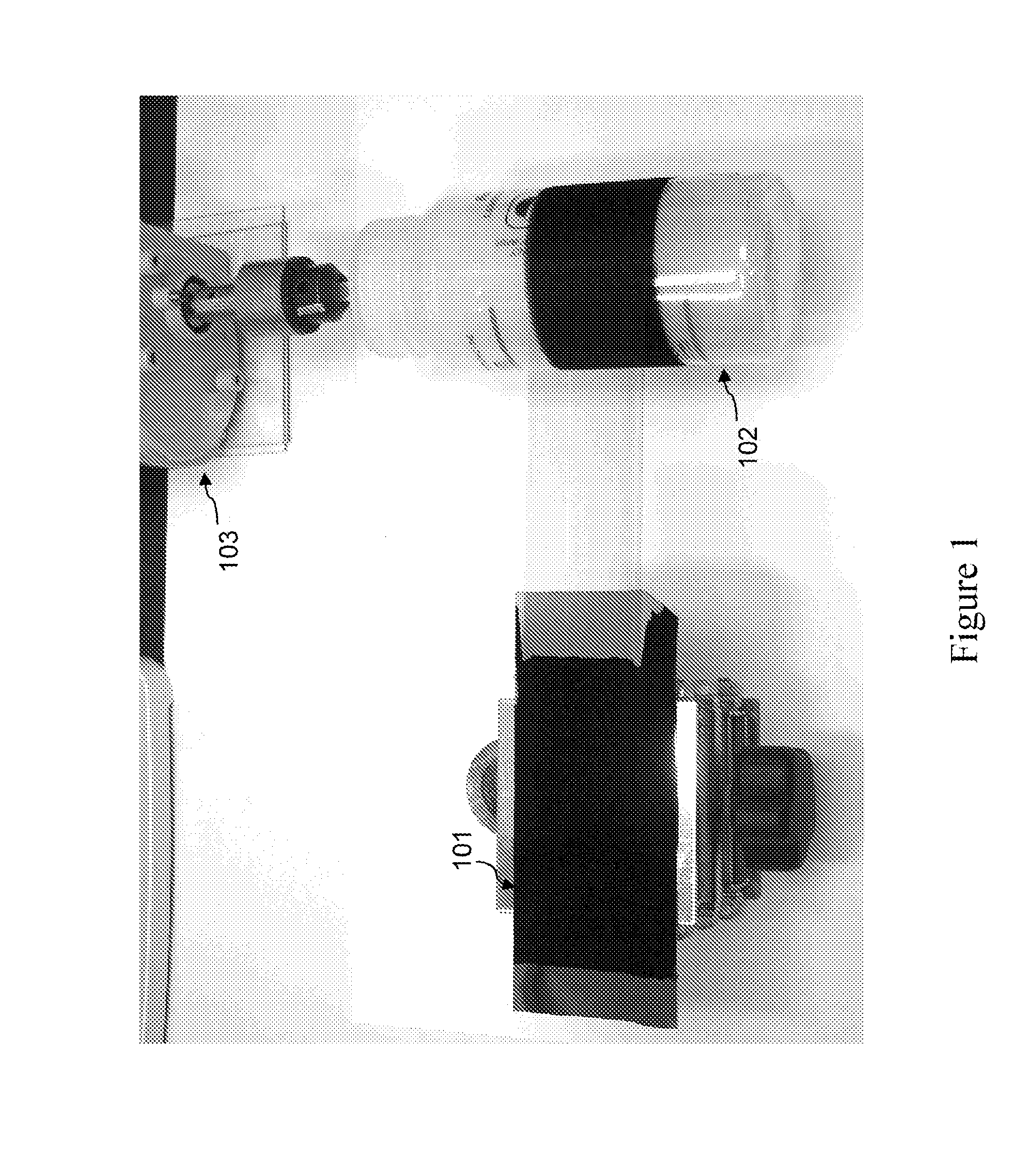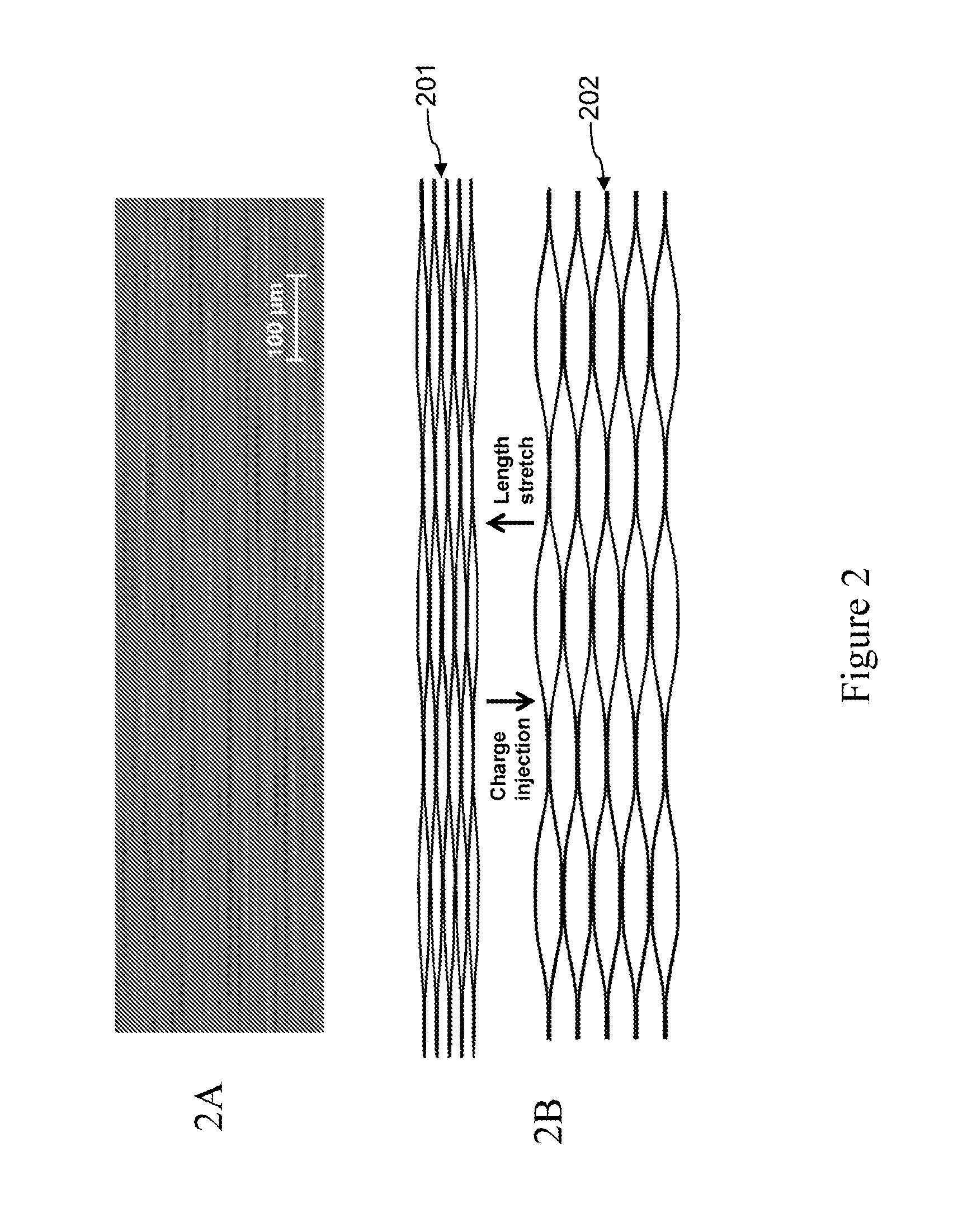Nanofiber Actuators and Strain Amplifiers
a technology of actuators and carbon nanotubes, applied in nuclear engineering, polarising elements, liquid/fluent solid measurements, etc., can solve the problems of humanoid robots lacking critical needed capabilities, most advanced prosthetic limbs, exoskeletons, etc., and the above described carbon nanotube artificial muscles are limited
- Summary
- Abstract
- Description
- Claims
- Application Information
AI Technical Summary
Problems solved by technology
Method used
Image
Examples
example 1
[0127]This Example 1 described the general methods used for forest-based fabrication and subsequent manipulation of individual carbon nanotube aerogel sheets and the fabrication of sheet stacks. The generally used method used for chemical vapor deposition (CVD) based MWNT forest synthesis and MWNT aerogel sheet fabrication has previously been described [M. Zhang et al., Science 309, 1215-1219 (2005)], though any method of forest synthesis that provides drawable nanotube forests can be deployed.
[0128]The synthesized nanotubes were typically ˜12 nm diameter, approximately nine walls, MWNTs that provided ˜25 nanotubes in an average bundle in the fabricated sheets. Sheet stacks were hand fabricated using a U-shaped metal frame to lift a sheet segment that was supported by a nanotube forest on one end and a wire support on the other end, during a process that both captured this sheet segment and reconnected the sheet to the original wire support (for repeat of this process during followi...
example 2
[0129]This Example 2 described some of the measurement methods used for characterizing width-direction and thickness-direction actuation for carbon aerogel artificial muscles. The measurement jig of FIGS. 19A-19B was used for measurement of actuation in width and thickness directions (FIGS. 5A-5B, 11, and 14) for actuator temperatures up to 1900 K for nanotube sheets and sheet stacks having fixed length. Since only the nanotube sheets were resistively heated to these temperatures, the jig temperature was much closer to ambient temperature. In a typical experiment (FIGS. 19A-19B), a nanotube sheet 1901 of described length and width was attached to the two rigid gold-coated copper electrodes 1902 and 1903 of the sample jig as shown in FIGS. 19A-19B.
[0130]Using 3 cm insulating pillars to reduce electric field distortions, this jig was attached to a stage that enabled the translational and rotational positioning needed for width and thickness measurements. Sheet width and thickness were...
example 3
[0131]This Example 3 demonstrated that large stroke actuation (expansion of over 200%) can result in width and thickness directions from applying a voltage to a carbon nanotube aerogel sheet electrode with respect to a counter electrode that is a distant ground plane. Unless otherwise indicated here and elsewhere herein, this voltage was chosen to be positive in order to avoid electrical energy losses due to electron emission. FIGS. 3A-3B provide photographs of a rigidly end-supported 50 mm long by 2 mm wide nanotube sheet strip before actuation (FIG. 3A) and a photograph of the same sheet strip expanded in width by applying 5 kV with respect to ground (FIG. 3B). The corresponding width-direction actuator strain, measured at sample center is about 220%. FIG. 3C is a photograph of a 25 mm long nanotube sheet strip actuated at 1500 K by applying 3 kV, showing that giant stroke actuation can be obtained at this extreme temperature.
[0132]FIG. 5A shows measured width-direction actuation ...
PUM
 Login to View More
Login to View More Abstract
Description
Claims
Application Information
 Login to View More
Login to View More - R&D
- Intellectual Property
- Life Sciences
- Materials
- Tech Scout
- Unparalleled Data Quality
- Higher Quality Content
- 60% Fewer Hallucinations
Browse by: Latest US Patents, China's latest patents, Technical Efficacy Thesaurus, Application Domain, Technology Topic, Popular Technical Reports.
© 2025 PatSnap. All rights reserved.Legal|Privacy policy|Modern Slavery Act Transparency Statement|Sitemap|About US| Contact US: help@patsnap.com



